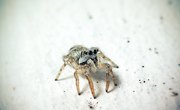Even though almost all spiders have venom and possess the ability to bite, most arachnids found in New Jersey gardens pose little to no risk to humans. In fact, most spiders are more scared of people than people are of them. A few potentially dangerous species reside in New Jersey, however, and knowing the habitat and appearance of these venomous spiders can help you avoid them.
Brown Recluse Spider
An adult brown recluse spider (Loxosceles reclusa) has a dark-brown to dull-yellow body that measures about 1/4 to 1/2 inch long, not including its legs. The most distinctive characteristic is the violin- or fiddle-shaped mark on the spider's back, extending from the front segment of the spider. Unlike most other spiders, which have eight eyes, the brown recluse has only six. Counting the eyes of a spider can be a bit difficult and dangerous without a magnifying glass or microscope, though.
The brown recluse dwells in woodpiles, barns and debris, as well as under rocks and logs. Indoors, the brown recluse prefers dark, sheltered areas, such as basements, behind furniture and in storage boxes. It hunts for its food instead of using its web to catch prey.
A bite from a brown recluse spider may go undetected until symptoms start to appear several hours later. In serious cases, tissue damage, cell death -- called necrosis -- and/or open wounds that won’t heal can occur from a brown recluse bite. The bite also poses a fatal risk to children, elderly people and individuals suffering from a weak immune system.
Black Widow Spider
Shiny and black, the black widow spider (Latrodectus spp.) is most recognized by the red hourglass shape on the underside of the female's abdomen. A male may have red and white marks on its abdomen. The body of a female black widow spider measures about 1 to 1 1/2 inches long while a male is about one-half that size.
This spider is attracted to dark, secluded locations, such as basements, dimly lit corners, garages, closets, woodpiles and crevices.
Long thought of as a deadly spider that bites at whim, the black widow is not aggressive and has a rather shy nature. Most bites occur when a black widow is threatened or attacked.
Although some may feel the pinprick bite of the black widow, many may not. The bite area typically swells, and the person bitten may experience abdominal cramping, excessive sweating, nausea, high blood pressure and spasmodic pain. Elderly people, children and individuals with a weakened immune system usually have more violent reactions than other people.
Sac Spider
The sac spider (Cheiracanthium spp.) is an outdoor arachnid that can make its way into homes. This green, tan or pale-yellow spider has a body that measures ¼-inch long and a dark, lance-shaped mark running down its abdomen.
Sac spiders create tubular silk sacs where they keep their eggs and rest during the day. These sacs are commonly found under leaves, bark and stones, and in trees and shrubs. In homes, the sacs are often between window blind slats, along ceilings and walls, in drapery folds and behind pictures.
Sac spiders are a bit more aggressive than average house spiders, and their bites are sometimes mistaken for brown recluse spider bites. Sac spiders don’t seek out people to attack, however.. Sac spiders are nocturnal hunters, and their bites typically occur when people have contact with the arachnids at night, such as when someone rolls over a sac spider in bed.
A sac spider bite may feel similar to a bee sting and causes an itchy welt to appear. Yellow sac spiders_,_ which are overly aggressive spiders, have a more serious bite that results in tissue death and a wound of dying tissue at the bite site. Cramps, nausea, malaise and fever are all common symptoms of a sac spider bite.
Emergency First Aid for Spider Bites
Seek emergency medical treatment if there is any chance that a spider bite was from a brown recluse, black widow or sac spider, or if the person bitten is elderly or a child. If it is possible to do so safely, capture the offending spider and take it with you so the doctor can properly identify the arachnid.
For a bite from another spider species, wash the bite location with soap and water, and apply a cold compress to the wound. If needed, use an over-the-counter pain reliever to treat symptoms. Keep a close eye on the bite location, and seek medical treatment if the victim becomes severely ill or has an allergic reaction, such as a rash.
Tips
It's best to err on the side of caution and seek medical treatment after experiencing a spider bite.
References
- MedicineNet.com: Spider Bites (Including Black Widow and Brown Recluse)
- Heritage Pest Control: New Jersey Spider Control
- Orkin: Brown Recluse Spiders
- Orkin: Black Widow Spiders
- Orkin: Yellow Sac Spiders
- University of Nebraska-Lincoln: Spider Bites? Look for a Sac Spider
- University of California-Riverside: How to Identify and Misidentify a Brown Recluse Spider
About the Author
Mika Flanigan has written for various publications such as BackHome Magazine. Fine Gardening Magazine and Mother Earth News. In 2012, Flanigan received the Master Gardener Certificate from WVU Cooperative Extension Program.
